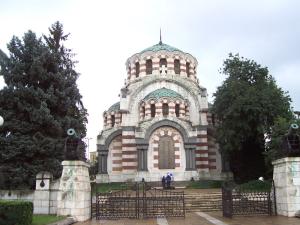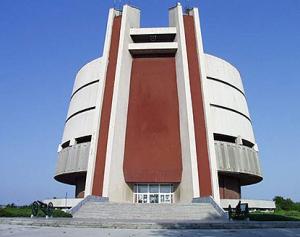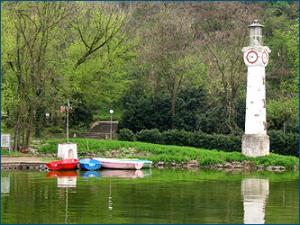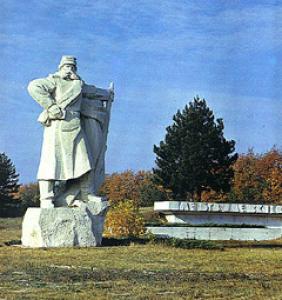Information about the town of Pleven
Pleven PropertiesThe town of Pleven has a population of 122 149 inhabitants. It is about 150 metres above sea level and is located in the central part of the Danubian Plain, past the Vit River. It is situated at the distance of 174 km to the north-east of Sofia, 35 km to the north of Lovech and 146 km to the south-west of Rousse. It is a town-pantheon. A regional administrative centre.
 enturies old and rich in events history. It originated in Thracian times on the place of today?s park of Kailuka and it was named Storgoziya, which name was preserved in Roman times as well. After its destruction by the barbarians, the Slavs rebuilt it under the name of Kamenets. A second settlement was set up to the north of it which was named Pleven (from ?plevel? which means weed). Later on the two settlements united and they were first mentioned under the name of Pleven in 1266 when the Magyars occupied it. After the 12th century the town developed as a craftsman?s and trade centre. The town put up a ferocious resistance to the Turkish invaders and that is the reason for its being destroyed and for its population being slaughtered, expelled and converted to Islam after its downfall. In 1596 Pleven was conquered and set on fire by the Wallachian Voivoda Mihail Vityaz (Hrabri) (the Courageous).
enturies old and rich in events history. It originated in Thracian times on the place of today?s park of Kailuka and it was named Storgoziya, which name was preserved in Roman times as well. After its destruction by the barbarians, the Slavs rebuilt it under the name of Kamenets. A second settlement was set up to the north of it which was named Pleven (from ?plevel? which means weed). Later on the two settlements united and they were first mentioned under the name of Pleven in 1266 when the Magyars occupied it. After the 12th century the town developed as a craftsman?s and trade centre. The town put up a ferocious resistance to the Turkish invaders and that is the reason for its being destroyed and for its population being slaughtered, expelled and converted to Islam after its downfall. In 1596 Pleven was conquered and set on fire by the Wallachian Voivoda Mihail Vityaz (Hrabri) (the Courageous).During the 17th and the 18th centuries the Bulgarian population in the town grew in number and took the trade and crafts in their own hands and started to develop its cultural life as well. The town became famous on the Balkan Peninsula and in Anatolia for its market of cattle and sheep (as of 1842). In 1825 a Bulgarian secular school was opened there, in 1840 - the first Bulgarian girls? school was opened by Anastassia Dimitrova and a year later a new boys? school was opened. In 1834 the Saint Nikolai Church was built and in 1845 its iconostasis was made. Dimitur Dospevski and Nikola Obrazopissetsa (the Image Painter) painted the icons. In 1869 a chitalishte (cultural centre and reading-club) was founded in the town, too. In 1871 Pleven had 3101 houses with the population of 17 000 people. On 6th May 1869 Levski set up the first secret revolutionary committee here. The citizens of Pleven took part in the detachments of armed volunteers of Philip Totyu and Hristo Botev.
Pleven became famous most of all with the events, which took place during the Russian-Turkish War of Liberation (1877-1878). The town quickly grew up after the Liberation. The newly built railway lines Sofia - Varna (Rousse) and Pleven (Yassen) - Somovit - Cherkovitsa greatly contributed to it. Today Pleven is the 7th biggest town in Bulgaria.
Almost all landmarks are related to the Russian-Turkish War of Liberation. About 200 monuments remind to the generations about the most sanguinary battles, which took place here. In the centre of the town there is a Mausoleum-Charnel House dedicated to the Russian and Romanian soldiers killed during the war. It was solemnly opened on 16th Sept ember 1907 in the presence of General Stoletov (the Commanding Officer of the Bulgarian volunteer forces). The architect of this outstanding monument is Pencho Koichev, and Prof. Ivan Truvnishki made the wood-carved lime-tree iconostasis. The iconostasis was highly acknowledged at the Paris exposition in 1906. Prof. Murkvichka and Prof. A. Mitov painted the icons. The Mausoleum is 24 m high. The Museum of the Liberation of Pleven is not far from there.
ember 1907 in the presence of General Stoletov (the Commanding Officer of the Bulgarian volunteer forces). The architect of this outstanding monument is Pencho Koichev, and Prof. Ivan Truvnishki made the wood-carved lime-tree iconostasis. The iconostasis was highly acknowledged at the Paris exposition in 1906. Prof. Murkvichka and Prof. A. Mitov painted the icons. The Mausoleum is 24 m high. The Museum of the Liberation of Pleven is not far from there.
The Skobelev Park was built up in the south-west part of the town, on a low hill (in the place of the old-time redoubts Isa aga and Kovanluka). Bratskata Mogila (common grave) (which preserves the bones of thousands Russian soldiers) as well as a lot of militant relics of that time is situated among its greenery and lanes. The renowned Pleven Epic 1877 Panorama is situated at the top of the hill, created in honour of the 100th anniversary of the Pleven Epic on analogy of the Borodin Panorama in Moscow. Through its original combination of artistic paintings, sculpture, authentic articles and explanatory texts, it provides for a sufficiently clear idea of the development of the events, especially those related to the third assault of the town.
The Town Museum of History is situated in the green zone on the left bank of the Touchenitsa River, not far from the centre. The remarkable monument to the citizens of Pleven who died in the Serbian - Bulgarian War of 1885 is situated in the small garden opposite it.
The unique of its kind Kailuka Park is situated in the immediate proximity of the town on the south in the valley of the Tuchenitsa River. Sheer rocks, over 20 metres high (here rock climbing races are held), exuberant vegetation, lakes, swimming pools, lanes, recreation corners, sports playgrounds, the eccentric Peshtera (Cave) Restaurant and another tourist infrastructure make it a favourite place for the citizens of Pleven and the visitors of the town.
Pleven is a big transport centre. There are regular bus lines to Sofia, Veliko Turnovo, Lovech, Troyan, Cherven Bryag, Levski, Knezha and a lot of other big and small settlements. Pleven is situated on the main railway line Sofia - Gorna Oryahovitsa - Varna (Rousse), and the local railway line for Somovit and Cherkovitsa starts from it, too. There is a town bus and trolley-bus transport functioning in Pleven.
The village of Grivitsa, a railway station on the railway line Sofia - Varna (Rousse) is situated at the distance of 6 km to the east of the town. During the War of Liberation sanguinary battles between Russians and Romanians on the one hand and the Turks, in defence of Pleven took place within the region of the village. A mausoleum in memory of the Romanian soldiers killed here was built in the village after the liberation. It is located amongst a spacious park with a lot of monuments and a common grave. One can go there from the town by a passenger train or by bus.
The town of Pordim is situated at the distance of 21 km to the east of Pleven. The General Headquarters of the Russian Army and of Emperor Alexander II was located here during the War of Liberation. The General Headquarters of the Russian Army Museum was set up here. There is another museum - Romanian Soldier 1877-1878, set up in the immediate proximity of a little house (preserved in its original appearance up to date) which accommodated the Headquarters of the Romanian units during the siege of Pleven. Pordim is also a station on the Sofia - Varna (Rousse) railway line. There is regular bus transport.
A green zone was arranged around Pleven of about 25 thousand decares, including the parks of Kailuka, General Lavrov, General Ge-net-ski, Grivitsa and others, which, serve as a filter against air pollution as well. The village of Vulchitrun is situated at the distance of 22 km south-east of Pleven, in which the Vulchitrun gold treasure was found in 1924 - a priceless monument of the late Bronze Era in our country. It is preserved in the National Museum of History in Sofia. There is a regular bus transport to the village both from the town and from Pordim.
others, which, serve as a filter against air pollution as well. The village of Vulchitrun is situated at the distance of 22 km south-east of Pleven, in which the Vulchitrun gold treasure was found in 1924 - a priceless monument of the late Bronze Era in our country. It is preserved in the National Museum of History in Sofia. There is a regular bus transport to the village both from the town and from Pordim.
The town of Dolni Dubnik - a town at the distance of 15 km to the west of Pleven with a lot of monuments from Pleven Epic. It is the greatest oil filed deposit in Bulgaria, natural gas is yielded here, too. The three dams in its surroundings are a favourite place for recreation, water motor sports, water tourism, and fishing. It is a station at the railway line of Sofia - Varna (Rousse). There are bus connections with Pleven.
The village of Gorni Dubnik (at the distance of 23 km to the west of Pleven), also a station at the railway line of Sofia - Varna (Rousse). Great battles during the War of Liberation took place here, too. The General V. N. Lavrov Park-Museum is located in the proximity of the village in the area connected with one of the most important moments related to the siege of Pleven. A lot of Russian soldiers headed by the regimental commander Lavrov found their death here. Today there lots of monuments and common graves reminding of those dramatic days when Bulgarian freedom was born. In addition to railway transport it can be reached by bus, too.
Pleven Properties

